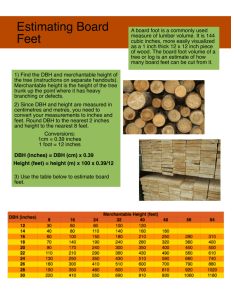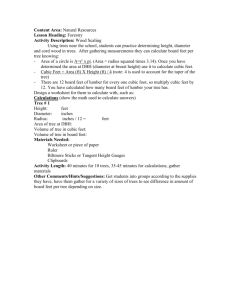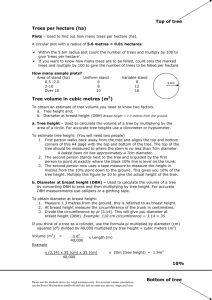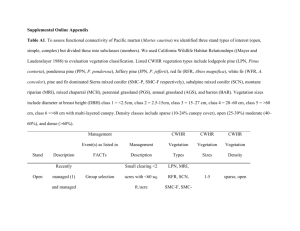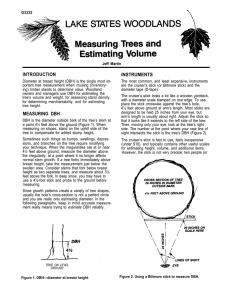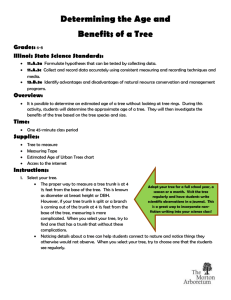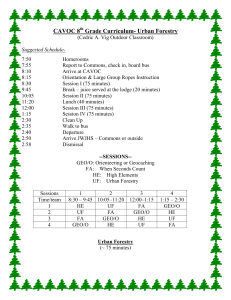Measurement of Forest Resources
advertisement
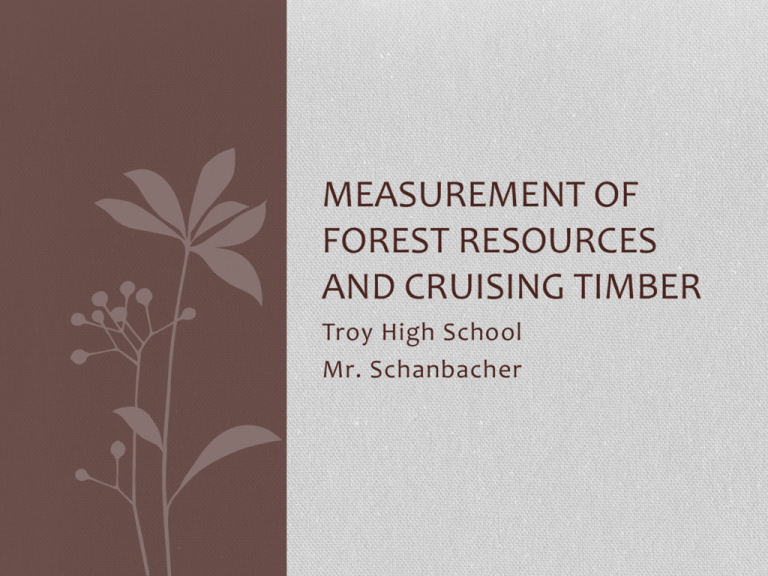
MEASUREMENT OF FOREST RESOURCES AND CRUISING TIMBER Troy High School Mr. Schanbacher Essential Questions • What is a topographic map? • How is a compass used? • What tools are used to estimate diameter and tree height? • How are the tools used to estimate tree diameter, height, and board feet? • How do you measure the age of a tree? • How do you calculate board feet? • What are the different log rule scales? • How do you calculate cords of wood? • How do you determine the basal area of a forest? • What are different methods of cruising timber? • What methods are used to scale logs? Cruising Timber Defined • Measurements of individual trees must be made to determine the volume of wood in each tree. The sum total of the individual tree volumes give you the total volume of the stand. We call this a cruise. In forest management we have a variety of units used to arrive at the tree or stand volume. Board Foot (BF) • One BF= 1’ X 1’ X 1” = 1 BF or 144 cubic Inches • Same as 12” X 12” X 1”/144 • Or L(ft) X W(in) X T(in) / 12 = BF • 1) 5 pieces 2” X 4” X 8’= • 2) 6 pieces 1” X 8” X 10’= • 3) 8 pieces 2” X 6” X 38”= • MBF= 1,000BF • Videos Click Here Smalian’s Formula • A more accurate way to scale logs • Will find the volume of a log using the following formula: • V= (A1 + A2) L/2 • V= Volume • A’s= Areas of Log Ends inside bark (A= 3.14 * R2) • L=Length Cord • 1 Cord = 4’ X 4’ X 8’ = 128 Cubic Feet • So.. L’ X W’ X H’ /128= # of Cords Face Cord and ½ Face Cord Other important measurements • ROD= 5.5 Yards or 16.5 feet • Chain= 22 Yards or 66 feet • Acre: 43,560 square feet • Perfect Acre is 660 ft X 66 Ft • or 220 Yards by 22 Yards • or 40 rods by 4 rods • This is roughly 210 ft X 210 Ft • Formula L(ft) X W(ft)/43,560=Acre • How many acres are in the following tracts of land: • 1,250’ X 585’ • 1.5 miles X 480 Yards • 230 chains X 450 Rods Diameter at Breast Height (DBH) • DBH: The diameter of a tree measured on the uphill side 4.5’ or 54” above the ground • Tools used to measure DBH (next slide) Normal Tree DBH Leaning Tree Forked Trees. A forked tree is a tree with two or more stems originating from one stump. Consider forking to start at the point where daylight is seen. When a tree forks below 4.5 feet, consider as two trees and measure DBH on each stem at 4.5 feet above the ground on the high side. When a tree forks at or above 4.5 feet, consider as one tree andrecord the smallest diameter at 4.5 feet or below. Abnormalities If Abnormalities Exist at BH • Diameter "A" = 16 inches • Diameter "C" = 18 inches • DBH = (16 + 18)/2 = 17 inches Butt Swell • Measure diameter above DBH where shape is normal, point "A.“ • Measure height to point "A," length "B.“ • Determine average taper from comparable trees of the same species in immediate area. • Interpolate DBH measurement "C" based on diameter measurement "A," the estimated average taper, and length "B.“ • Diameter "A" = 18.0 inches • Length "B" = 12 feet • Estimated taper = 2 inches in 8 feet or .25 inches per foot • DBH = 18 + ((12 - 4.5) x .25) = 19.88 inches or 19.9 inches Trees Growing on Objects Tree Caliper: Usually Most Accurate Diameter Tape • Diameter Tape. This is the most common device used to measure tree diameters. Tapes are either 20 or 50 feet long, are made of steel, usually have a bark hook on the zero end, and arc graduated on the outside surface in inches and tenths of inches of diameter equivalents (3.1416 inches) of circumference. Many tapes also have linear graduations in feet or meters on the inside surface. Many logger’s tapes are graduated on the backside in diameter equivalents of circumference. • Very accurate for round trees, not perfect for out of round trees How to Read it! 5.3 5.4 5.6 Using a Biltmore Stick for DBH Biltmore Stick •Hold 25” from eye •Line Left hand side up with edge of tree at BH •Read DBH on the Right hand side of the tree Biltmore Stick Hypsometer • One Chain = 66’ Merchantable Height • Merchantable height is the height of the tree (or the length of its trunk) up to which a particuar product may be obtained, usually minus a one-foot stump height. Merchantable tree heights for sawlogs and veneer are generally estimated to the height where the trunk diameter tapers to 10 inches, or until heavy branching or defects are encountered. The merchantable height of very valuable trees, such as veneer black walnut, may be measured to the nearest foot or two feet. The merchantable height of most other trees is measured in units of 16-foot logs and 8-foot half-logs. Merchantable height measurements are rounded to the nearest half-log. Thus, a tree with a merchantable height of 42 feet would be measured as having 2-1/2 logs of merchantable height. Merchantable Height Cont. • Merchantable heights may be measured with a number of special instruments designed specifically for tree-height measurements such as clinometers, altimeters, relascopes, or hypsometers. These instruments are available through forestry equipment supply companies. Merchantable heights can also be measured with a long pole if only a few trees are being measured and they have relatively short merchantable heights. With some practice, merchantable heights in log and half-log units can be estimated quite accurately, particularly for trees with short merchantable heights. Merchantable Height Click Here and Here Hypsometer and Clinometers Altimeter Lumber Scales • Scribner: Used by most mills; Quite Accurate • Doyle: Often Used for Veneer Log Scaling; Favors Log Buyer for Logs Less than 28” • International 1/4: Most Accurate; Still Not Widely Used??? • Older scales are probably still used because even though they are not as accurate the pricing systems has always been based on them. Click Me Please
